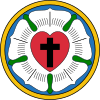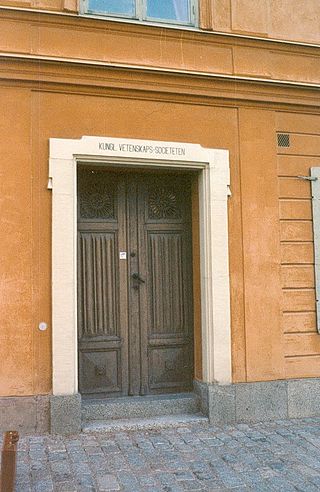
The Royal Society of Sciences in Uppsala, is the oldest of the royal academies in Sweden, having been founded in 1710. The society has, by royal decree of 1906, 50 Swedish fellows and 100 foreign.
The Royal Swedish Naval Staff College was a Swedish Navy training establishment between 1898 and 1961, providing courses for naval officers. It was the home of the Swedish Navy's staff college, which provided advanced training for officers. It was located within the Stockholm garrison in Stockholm, Sweden.

Carl Einar Thure af Wirsén was a Swedish Army officer, diplomat and writer. Originally an officer, he was sent into the diplomatic service after World War I and served as a military attaché in Constantinople and Sofia where he witnessed the Armenian genocide. From the Ottoman Empire and the Balkans, af Wirsén came to Poland and witnessed the country's resurrection. After serving in London, Reval and Riga, he was sent as envoy to Bucharest, Athens and Belgrade in 1921. After working in the Mosul Commission, af Wirsén was sent to Berlin, where he would stay for the next 12 years as envoy. Finally he was envoy in Rome for three years before retiring in 1940.

Hovjägmästare in Sweden was a court official who supervised the Kungliga Hovjägeristaten at the Royal Court of Sweden and the royal hunting parks. The first hovjägmästare was originally the title of the head of the Kungliga Hovjägeristaten and later the title of any among the hovjägmästare. Today there is a hovjägmästare at the Royal Court of Sweden with the task of assisting in the planning of royal hunts. Hovjägmästare can be translated as Master of the Chase or Master of the Buckhounds and Överhovjägmästare can be translated as Grand Master of the Huntsmen.
Karlskrona Artillery Corps was a coastal artillery unit of the Swedish Navy which operated between 1893 and 1902. The unit was based in Karlskrona in Blekinge.

The Surgeon-General of the Swedish Armed Forces is the highest-ranking medical officer of the Swedish Armed Forces. The Surgeon-General is responsible for the supervision of the Swedish Armed Forces, the Defence Materiel Administration, the Swedish Fortifications Agency and the National Defence Radio Establishment. This includes supervision in the areas of environment, health, nature, sewage, waste and chemicals.
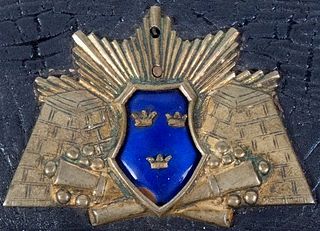
The Vaxholm Artillery Corps was a corps-level artillery formation of the Swedish Army which operated between 1889 and 1901. The unit was based in Vaxholm in Uppland.
The Swedish Army Veterinary Corps was an administrative corps for veterinarians of the Swedish Army from 1887 to 1969. Its task was, in peace as well as in war, to provide army units etcetera with especially trained staff for veterinary positions in the army.
The Swedish Naval Medical Officers’ Corps was an administrative corps established in 1902 for military physicians in the Swedish Navy and in the Swedish Coastal Artillery. The corps was amalgamated into the Medical Corps of the Swedish Armed Forces in 1969.
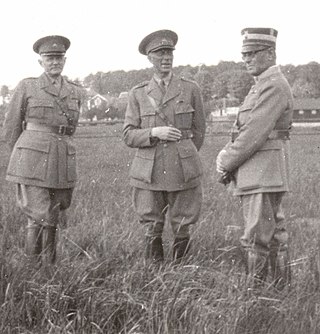
The Deputy Chief of Ordnance was in Sweden the head of the Swedish Army's ordnance establishments. During the 1800s and 1900s, his duties changed several times. The position was abolished in 1968.

General Gustaf Fredrik Oskar Uggla was a senior Swedish Army officer. Uggla had a distinguished military career in Sweden during the late 19th and early 20th centuries. Commissioned in 1863, he rose through the ranks, serving in various capacities, including as a teacher at the Royal Military Academy and as a military attaché in Vienna. Uggla's career highlights include commanding the Royal Military Academy and later the 2nd Army Division. He retired as a general in 1913 but continued contributing to military committees.

Lieutenant General Herman Georg Waldemar Wrangel was a senior officer in the Swedish Coastal Artillery. He served as commanding officer of the Swedish Coastal Artillery for 15 years (1909–1924). Wrangel served as secretary, member and chairman of a number of committees and commissions. Wrangel was also a member of the Upper House of the Riksdag and a member of the Committee on Defence as well as of the Committee of Supply.
Flag captain was in the Swedish Navy a captain or commander who served as deputy to a fleet commander. During the 1900s, the flag captain served as chief of staff of Flaggen, the staff of the Chief of the Coastal Fleet.
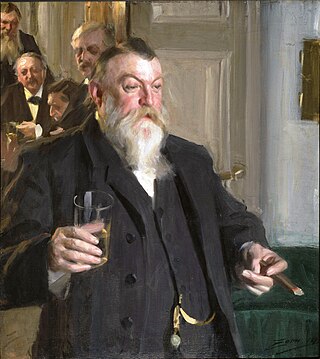
Sällskapet Idun is a Swedish association for men, founded in 1862 in Stockholm.

Gustaf Isak Kolthoff was a Swedish ornithologist, taxidermist and naturalist. He worked as a curator of the museum at Uppsala and set up a private museum where he is credited with the creation of the first naturalistic dioramas which became a popular format in European natural history museums.
Landstorm was a form of militia and territorial defence force created in Sweden in 1885. It consisted of all conscripts who had completed their service, generally men between 33 and 40 years of age, as well as a smaller number immediately transferred there. The landstorm was intended "for the defence of the home town" within "own or nearest neighboring enlistment districts." The landstorm was first raised in time of war, in the parts of the country most threatened by the enemy, and organized according to existing conditions and provided with commanders based on advice and quarters. The landstorm was abolished in 1942.
Sekundlöjtnant was, according to the regulation of 1824, a subaltern rank in the Swedish Navy with two salary classes, the higher one carrying the rank of löjtnant (sub-lieutenant) and the lower one carrying the rank of underlöjtnant. In 1841, the older class was given the name premiärlöjtnant, while the younger class retained its title until 1866, when the navy was divided. The names of the mentioned ranks were then changed to löjtnant and underlöjtnant, with corresponding ranks as in the Swedish Army.
The Marine Regiment was a naval artillery unit within the Swedish Navy that operated from 1824 to 1886. The unit was created in 1845 from the former Naval Artillery Regiment and was intended for garrison and guard duty at naval stations and fortifications, as well as for landing operations on ships. In 1871, the Marine Regiment was put on the list for disbandment but was revived again when it was transferred to the army as part of the Blekinge Battalion in 1886.
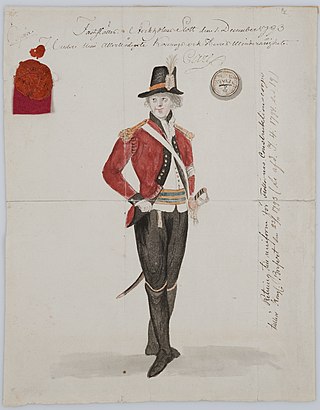
The Swedish Navy Construction Corps was, during the years 1793–1868, a military organized corps in the Swedish Navy, primarily tasked with creating drawings and proposals related to naval materiel and overseeing work at the Swedish state shipyards.
The Swedish Navy Mechanical Corps was a Swedish Navy corps with naval engineers from 1814 to 1868. In 1816, it was stipulated that the organization responsible for shipbuilding work in Karlskrona, known as the Byggnadsstaten, would be transformed into a special unit called the Swedish Navy Mechanical Corps after the completion of this work. This corps ceased to exist with the organization of the Mariningenjörsstaten in 1868.
















